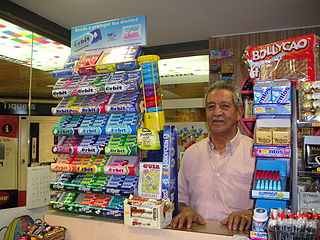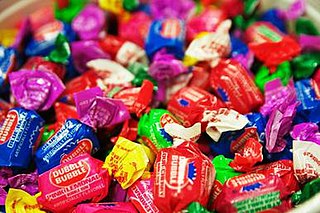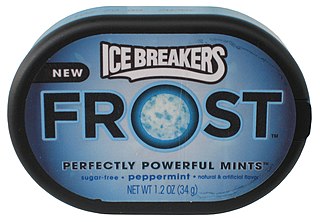
Bubble gum is a type of chewing gum, designed to be inflated out of the mouth as a bubble.

Chewing gum is a soft, cohesive substance designed to be chewed without being swallowed. Modern chewing gum is composed of gum base, sweeteners, softeners/plasticizers, flavors, colors, and, typically, a hard or powdered polyol coating. Its texture is reminiscent of rubber because of the physical-chemical properties of its polymer, plasticizer, and resin components, which contribute to its elastic-plastic, sticky, chewy characteristics.

The Wm. Wrigley Jr. Company, known as the Wrigley Company, is an American multinational candy and chewing gum company, based in the Global Innovation Center (GIC) in Goose Island, Chicago, Illinois.

A joy buzzer is a practical joke device that consists of a coiled mainspring inside a disc worn in the palm of the hand. When the wearer shakes hands with another person, a button on the disc releases the spring, which rapidly unwinds creating a vibration which mimics an electric shock to the unsuspecting victim.
"No soap radio" is a form of practical joke and an example of surreal comedy. The joke is a prank whereby the punch line has no relation to the body of the joke, but participants in the prank pretend otherwise. The effect is to either trick someone into laughing along as if they "get it" or to ridicule them for not understanding.

Orbit is a brand of sugarless chewing gum from the Wrigley Company. In the United States, where it was re-launched in 2001, it is sold in cardboard boxes with 14 individually wrapped pieces per package. In the UK, where it was launched in 1899 it was originally sold as a traditional long-stick gum, later replaced by the same format as the US.

Trident is a brand of sugar-free chewing gum. It was originally introduced by American Chicle in 1960 shortly before it was bought by Warner-Lambert in 1962. It reached the UK in 2007 when it was introduced by its then-owner Cadbury Schweppes in the United Kingdom. In many other European countries, Trident is branded as Stimorol gum; it is generally the same as Trident.
The sale of chewing gum in Singapore has been illegal since 1992. Some motivations for the ban included stopping the placement of used chewing gum in inappropriate and costly places, such as the sensors of subway doors, inside lock cylinders, and on elevator buttons. Since 2004, an exception has existed for therapeutic, dental, and nicotine chewing gum, which can be bought from a doctor or registered pharmacist. It is not illegal to chew gum in Singapore, but it is against the law to import it and sell it, apart from the aforementioned exceptions. According to a BBC News article, it is legal for a traveler to bring in a small amount of chewing gum for personal use, and there is a fine for spitting the gum out in an inappropriate place.

Dubble Bubble is an American brand of fruit-flavored, usually pink-colored, bubble gum invented by Walter Diemer, an accountant at Philadelphia-based Fleer Chewing Gum Company in 1928. One of Diemer's hobbies was concocting recipes for chewing gum based on the original Fleer ingredients. Though founder Frank H. Fleer had come up with his own bubble gum recipe under the name Blibber-Blubber in 1906, it was shelved due to its being too sticky and breaking apart too easily. It would be another 20 years until Diemer would use the original idea as inspiration for his invention.
Walter E. Diemer was an American accountant who, in 1928, invented bubble gum.
Freedent is a brand of chewing gum manufactured by Wrigley's. Freedent was first introduced in the US and UK in 1975 and is marketed as the gum that "won't stick to most dental work ." Freedent comes in eight flavors: Winterfresh, Peppermint, Spearmint, Bubble Gum, Fruit, Strawberry, Eucalyptus, and Blueberry. It also comes in two package sizes: single packs containing 15 sticks of gum, and multi-packs containing 8 packs of 5 sticks each. Sugar-free versions of Freedent are also available in several countries, including France.

A practical joke or prank is a trick played on people or people, generally causing the victim to experience embarrassment, perplexity, confusion, or discomfort. The perpetrator of a practical joke is called a "practical joker" or "prankster". Other terms for practical jokes include gag, rib, jape, or shenanigan. Some countries in western nations make it tradition to carry out pranks on April Fools' Day and Mischief Night.

The White Balloon is a 1995 Iranian film directed by Jafar Panahi, with a screenplay by Abbas Kiarostami. It was Panahi's feature-film debut as director. The film received many strong critical reviews and won numerous awards in the international film fairs around the world including the Prix de la Camera d'Or at the 1995 Cannes Film Festival. The Guardian has listed this film as one of the 50 best family films of all time. The film is on the BFI list of the 50 films you should see by the age of 14.

A practical joke device is a toy intended to confuse, frighten, or amuse individuals as a prank. Often, these objects are harmless facsimiles of disgusting or terrifying objects, such as vomit or spilled nail polish. In other instances, they are created as seemingly harmless items designed to humorously malfunction in such a way as to confuse or harm the target of a prank. The devices are frequently sold in magic or specialty shops, purchased over the Internet, or crafted for oneself. Perhaps the most notable such device is the whoopee cushion.

5 is a brand of sugar-free chewing gum that is manufactured by the Wrigley Company, marketed toward teenagers. The name "5" hints at the five human senses and that it has 5 calories.

Shocking gum is a practical joke device that delivers a mild electric shock. The victim is offered what appears to be the last stick of chewing gum from a box, and touching or pulling this triggers the shock. A few novelty companies have produced "shocking gum" packages since the 1950s, depicting fictitious brands such as Fruit Juicy and JB.

The Gum Wall is a brick wall situated beneath Pike Place Market in Downtown Seattle, Washington, United States. Located on Post Alley near Pike Street, south of the market's main entrance off 1st Avenue, the wall is covered with used chewing gum. Certain sections of the gum accumulation on the walls measure several inches in thickness, reaching a height of 15 feet along a 50-foot-long segment. Originating inadvertently in the 1990s, the Market Theater Gum Wall has evolved into a notable tourist attraction and local landmark.
The hot foot is a prank where the prankster sets the victim's shoe laces or shoe on fire with a match or lighter.

Ice Breakers is a brand of mints and chewing gum owned by The Hershey Company.













